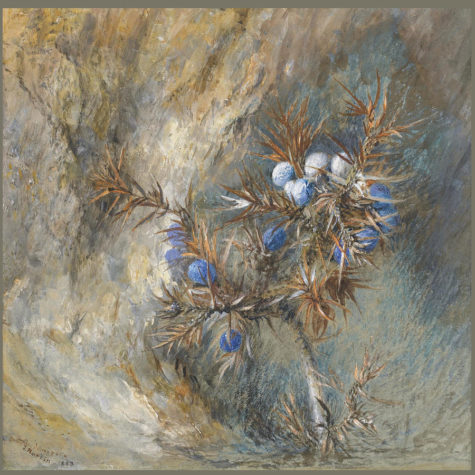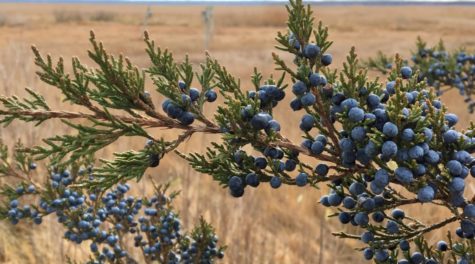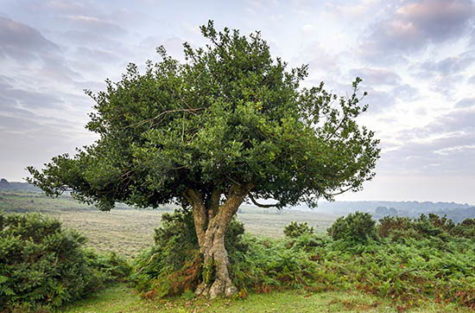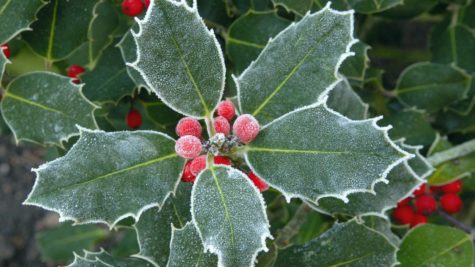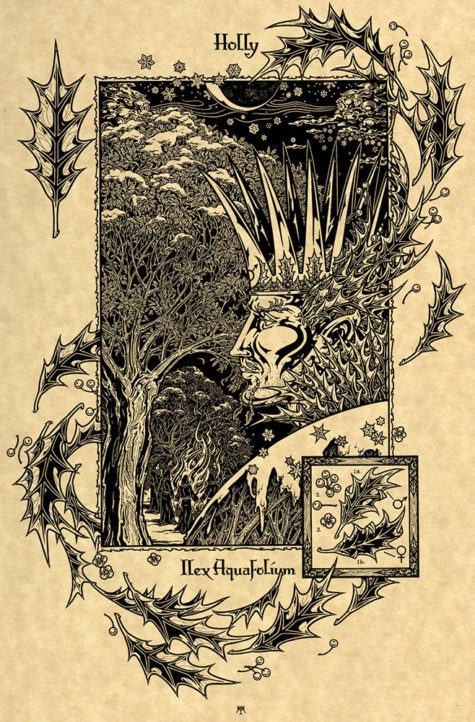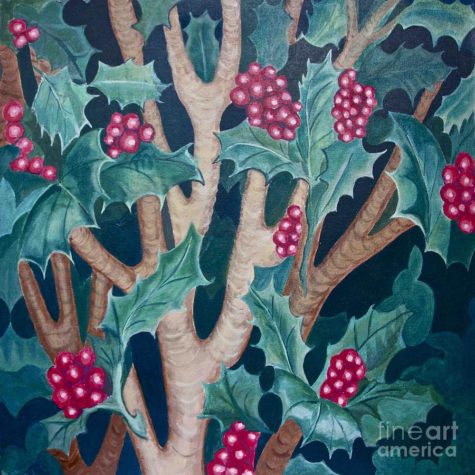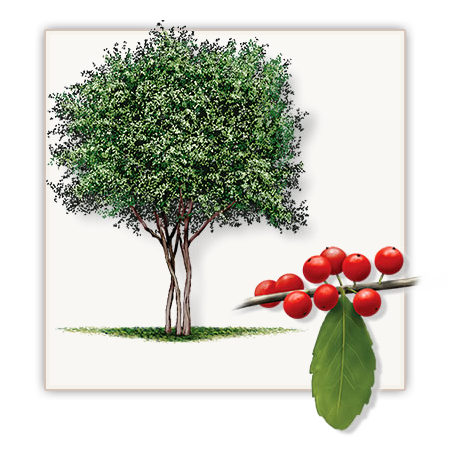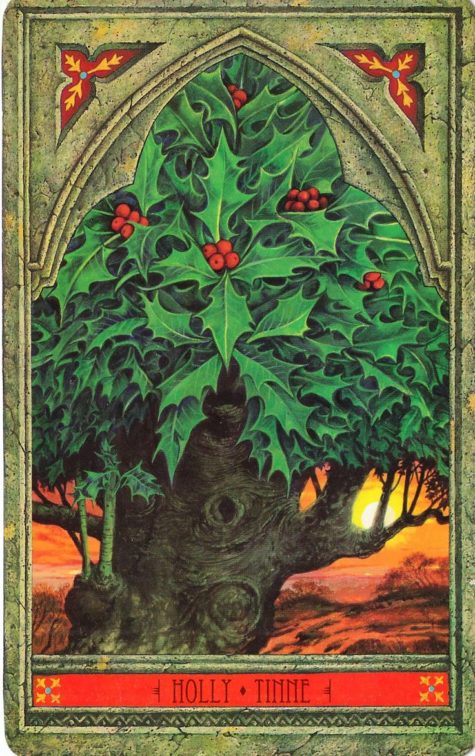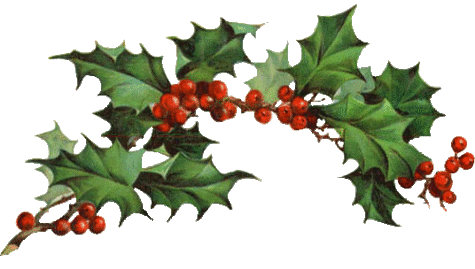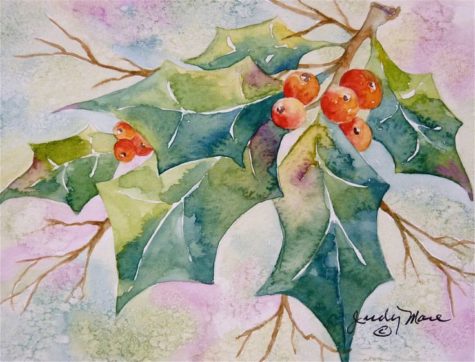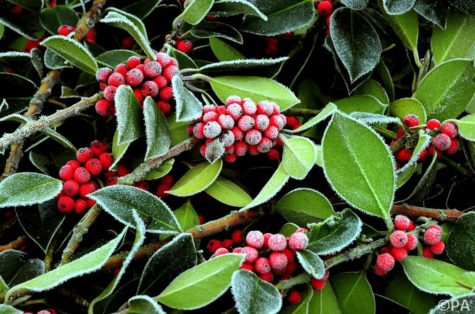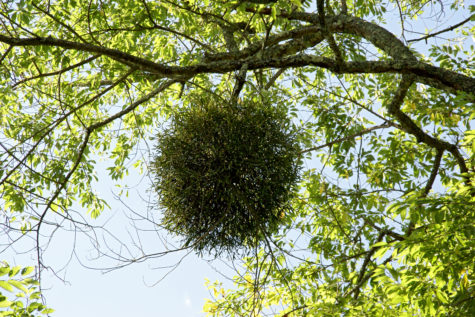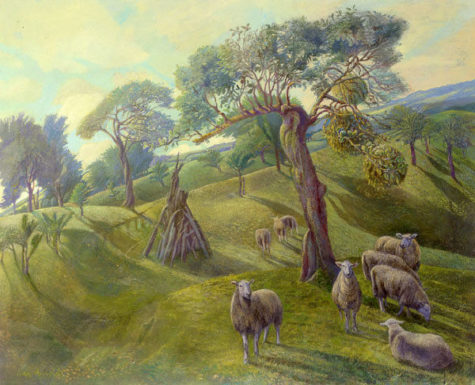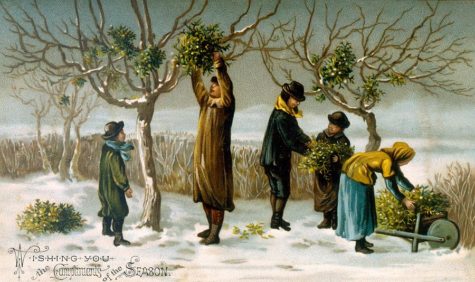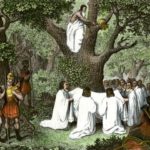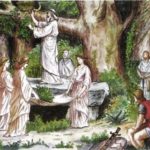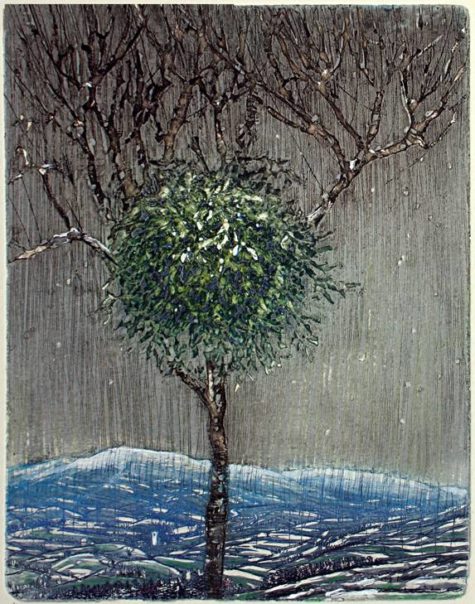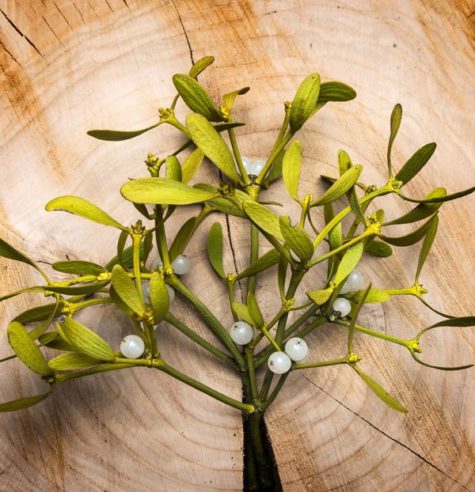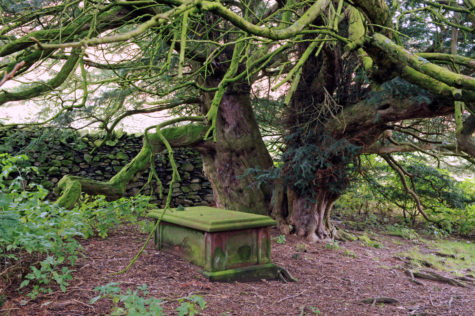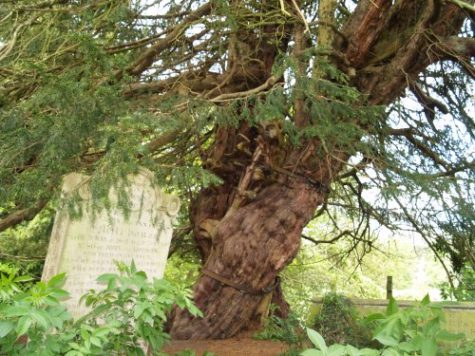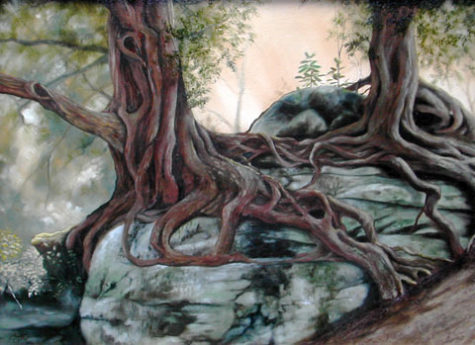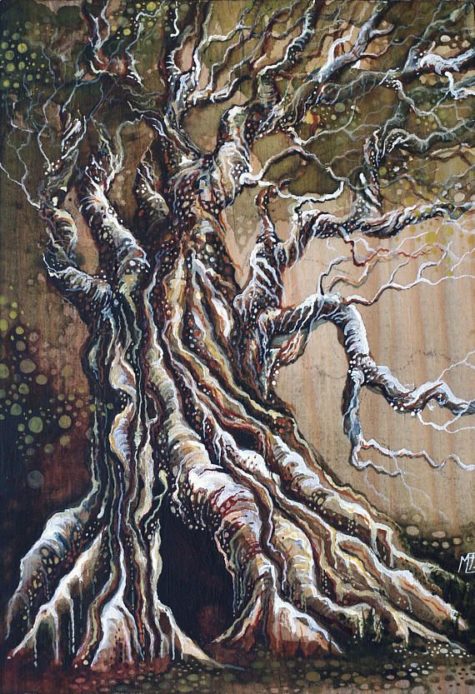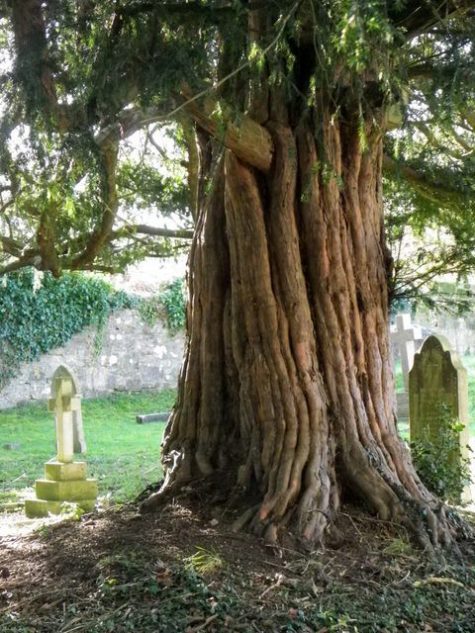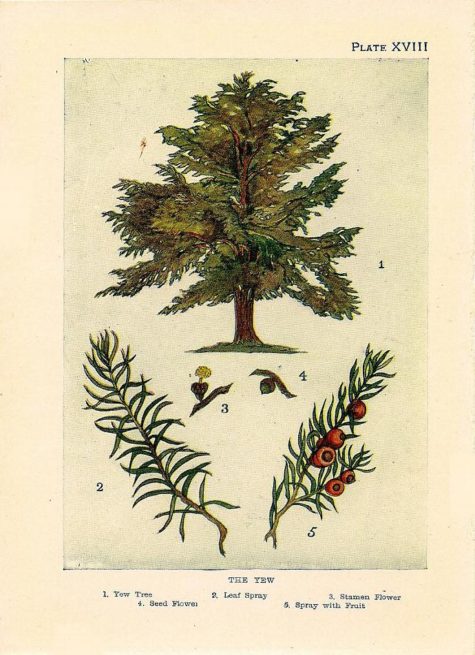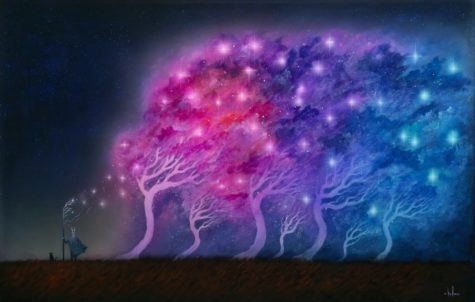Trees
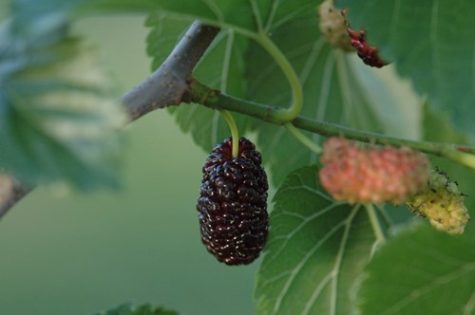
Magickal Uses
- Ruler: Mercury
- Type: Tree
- Folk Name: Blood of a Goose (tree sap)
- Magickal Form: Wood, Berries
- Magickal Properties: Insight, Courage, Focus
Add the berries to success spells for insight and inspiration. A mulberry leaf should be placed near the crib to protect the baby.
Sleep with Mulberry leaves under your pillows to have psychic dreams. Make a tea from the leaves and use the brew to draw protection sigils. Carry the leaves as a talisman for strength and courage. Meditate under the tree to sync your subtle bodies.
Use wood from this tree to craft a wand that will boost your willpower. A Mulberry wand will also bring more focus and clarity to ritual. It helps to center the practitioner, increase magickal awareness, and bring sudden insight, revelation, or Cosmic knowledge.
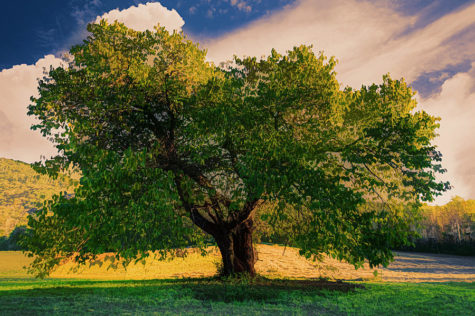
Mulberry Symbolism
Here are a few key words when it comes to the personality and symbolic meaning of this lovely tree:
- Caring
- Exploring
- Providing
- Nurturing
- Attraction
- Survivalist
- Adventurous
The mulberry is typically a fast growing bush-tree, and it will quickly take over a domain when happy. By association, mulberry tree people will expand, explore, seek, find and spread their wings to great lengths when living in the right environment.
Mulberries are such giving plants. They provide food for humans and animals alike. People connected to the mulberry tree meaning, will have the same tendency to give, provide, protect and nurture others around them.
In this same light, mulberries are natural magnets for all kinds of life. The lovely shade they provide and their delicious berries attract lots of interesting beings…from humans to birds to deer and more.
When connected to the mulberry tree, we can also attract lots of interesting people, nature, experiences, opportunities. Mulberry people will be quite fortunate, and can be like a vortex…calling to themselves who and what they needs.
This is largely due to the mulberry’s ability to remind us all about the understanding of give and take. The mulberry shows us that as we give, energy will be given to us as well. It is the Law of Reciprocation, and he will have an innate understanding about this.
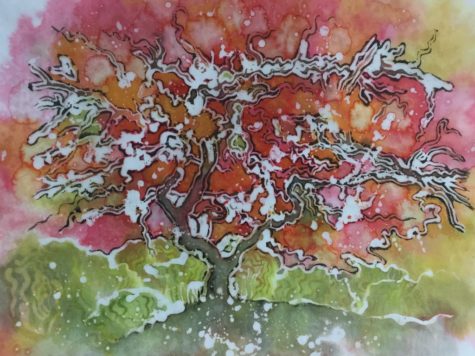
Mulberry Dreaming
There are many conflicting ideas about what mulberries mean in dreams. This is what I found:
- Eating mulberries in a dream mean increase in one’s earnings, praiseworthy religious assiduity, good faith, certitude and leading a healthy life.
- The mulberry tree in a dream represents a wealthy person with many children.
- Mulberry in a dream also could mean borrowing money.
- A mulberry tree in a dream also represents a wealthy and a generous man with a large family.
- Eating black mulberry in a dream also means prosperity.
- Dreaming of eating mulberry means windfall profits.
- Dreaming of mulberry, that disease will prevent you from fulfilling your wish, and friends often visit you, hoping that your help can alleviate their pain and suffering.
- The woman dreamed of eating mulberry, indicating that she could give birth to a child with great achievements in the future.
- Dreaming of eating mulberry foreshadows something that is painful and disappointing.
- A pregnant woman dreaming of eating mulberry, implies that she would have a noble child.
- If you are a married woman, you are about to conceive , or you will give birth to bright, intelligent children in the future, which will make your family prosper.
And then there was this confusing explanation:
This dream has good luck and bad luck. Those who dream of mulberry trees must be young and have no blunders; those who dream of mulberry trees who are thin have less interest and are better. Dreamed that if the mulberry tree withered, the Lord’s good luck. Planting mulberry trees is difficult to protect. Mulberry trees in the rain are difficult to eat. Body tied to mulberry, internal heart injury.
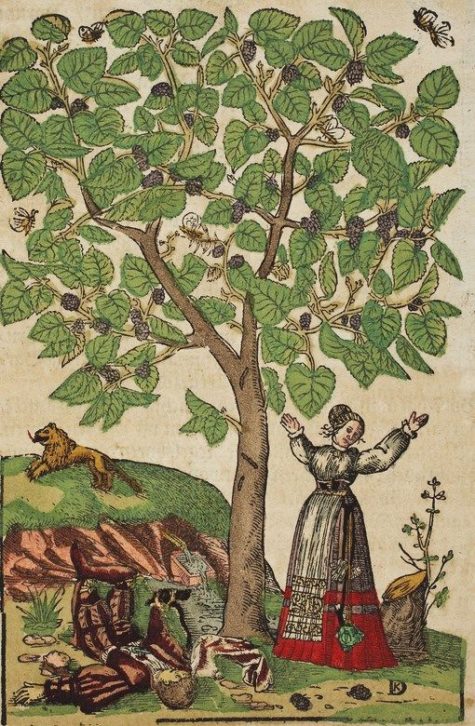
History and Lore
According to a German folklore, the roots of mulberry tree are often used by the devil to polish his boots (and therefore, these trees are associated with evil).
In China, the mulberry is considered the World Tree that connects the Heavens, the Earth and the regions below.
There was a sacred grove of mulberry trees planted outside the eastern gate of the early royal cities, and the tree was associated with this direction because as the “house” of the Mother of the Suns, the Sun rose every day by climbing up the Mulberry tree.
The wood of the tree was used to make bows that “shot” away evil influences that emanated from the compass points.
There is evidence that the Mulberry was revered in Islam too, since the tree can be found close to Muslim sanctuaries.
Mulberry paper is used as vessels for offerings in Shinto shrines. Japanese families often used mulberries as a part of their family crests, and strips of the fiber were hung from sacred trees as prayers. The mulberry leaves were also used to feed silk worms, who produced the fiber to make kimonos fit for the ruling class. In all of these capacities, the mulberry represents support, nurturing and self-sacrifice.
The Romans ate Mulberries at their feasts, as we know from the Satires of Horace, who recommends that Mulberries be gathered before sunset.
We also find mention of the Mulberry in Ovid, who in the Metamorphoses refers to the legend of Pyramus and Thisbe, who were slain beneath its shade, the fruit being fabled to have thereby changed from white to deep red through absorbing their blood.
Pliny speaks of its employment in medicine and also describes its use in Egypt and Cyprus. He further relates:
“Of all the cultivated trees, the Mulberry is the last that buds, which it never does until the cold weather is past, and it is therefore called the wisest of trees. But when it begins to put forth buds, it dispatches the business in one night, and that with so much force, that their breaking forth may be evidently heard.”
It has been suggested that the generic name of the Mulberry, Morus, has been derived from the Latin word mora (delay), from this tardy expansion of the buds.
As the wisest of its fellows, the tree was dedicated by the Ancients to Minerva.
Sir Walter Scott relates in his famous story Ivanhoe that the Saxons made a favorite drink, Morat, from the juice of Mulberries and honey.
There are many famous Mulberry trees in England. Those of Syon House, Brentford, are of special historical interest and include what is reported to be the oldest tree of its kind in England, said to be introduced from Persia in 1548.
It is this particular and venerable tree which forms the subject of an illustration in London’s Aboretum and Fruticetum. Although a wreck compared to its former self, it is regarded as one of the largest Mulberry trees in the country. Its height is given by Loudon as 22 feet, and additional interest is attached to this tree, as it is said to have been planted by the botanist Turner.
In 1608 James I, being anxious to further the silk industry by introducing the culture of the silkworm into Britain, issued an edict encouraging the cultivation of Mulberry trees, but the attempt to rear silkworms in England proved unsuccessful, apparently because the Black Mulberry was cultivated in error, whereas the White Mulberry is the species on which the silkworm flourishes.
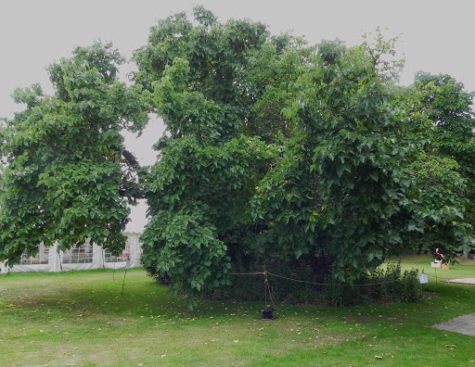
Shakespeare’s Famous Mulberry
Shakespeare is said to have taken a Mulberry tree from the Mulberry garden of James I, and planted it in his garden at New Place, Stratford-on-Avon, in 1609. This also was a Black Mulberry, “cultivated for its fruit, which is very wholesome and palatable; and not for its leaves, which are but little esteemed for silkworms.”
“The Tree,” Malone writes, “was celebrated in many a poem, one especially by Dibdin. But in about 1752, the then owner of New Place, the Rev, Mr. Gastrell, bought and pulled down the house and cut down Shakes’eare’s celebrated Mulberry tree, to save himself the trouble of showing it to those whose admiration of the poet led them to visit the ground on which it stood.”
The pieces were made into many snuff boxes and other mementoes of the tree, some of them being inscribed with the punning motto, “Memento Mori.”
Ten years afterwards, when the freedom of the city was presented to Garrick, the document was enclosed in a casket made from the wood of this tree. A cup was also made from it, and at the Shakespeare Jubilee, Garrick, holding the cup, recited verses, composed by himself in honor of the Mulberry tree planted by Shakespeare:
“Behold this fair goblet: ’twas carved from the tree
Which, oh, my sweet Shakespeare, was planted by thee!
As a relic I kiss it, and bow at thy shrine,
What comes from thy hand must be ever divine.”
“All shall yield to the Mulberry tree;
Bend to the blest Mulberry:
Matchless was he who planted thee,
And thou, like him, immortal shall be.”
A slip of it was grown by Garrick in his garden at Hampton Court, and a scion of the original tree is now growing in Shakespeare’s garden.
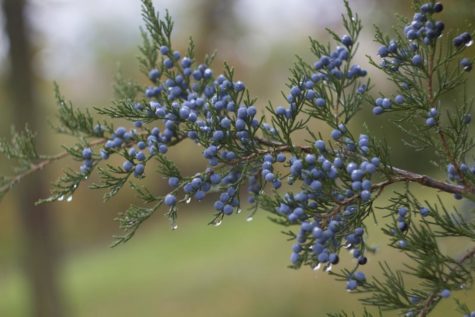
- Ruler: Sun
- Magickal form: Incense, fresh sprigs, berries, essential oil
- Basic Powers: Protection, Love, Healing, Cleansing
- Cautions: Do not drink the tea if you are pregnant, wish to become pregnant, or if you have kidney disease.
In the past, Juniper was regarded as a magick shrub to use against devils, evil spirits, and wild animals. It is mentioned in the Bible as a symbol of protection. Its aromatic scent made it a popular strewing herb, and shoots were burned to disinfect the air in a room.
Brew the berries into a tea and drink it to increase sexual stamina. Crush dried berries to release their scent and add to love potions to attract a man. String the matured berries for an attractive charm designed to attract lovers.
Juniper berries can be used in love spells, particularly to enhance male interest and potency. Steep in wine and drink a few sips daily to increase male virility. Steep in vinegar and add it to your bath to make yourself more attractive to men or apply it directly to the genitals (diluted with water) to increase male interest in them. Or add it to a bath you’re sharing. Juniper berries and their essential oils make for a nice “masculine” scent for men’s cosmetics (aftershave, beard oil, etc.). Use with due caution.
Hang a sprig of fresh Juniper in the home to drive away evil. A sprig of Juniper will protect the wearer from accidents. Sometimes used in anti-theft sachets, as it guards against thieves. Grow Juniper at your doorstep for protection. Gin (which is made from Juniper) can be sprinkled across a threshold to guard against theft.
Juniper is a thief catcher. If you bend a young Juniper branch down to the ground and hold it where you place it with two weights, one a big stone, the other the skull of a murderer, and say, “Juniper, I bend and squeeze you till the thief (name him) returns what he has taken to its place,” the culprit will feel an unaccountable impulse to return the property.’
Brush down the body with a bundle of sprigs to remove illness and place drops of oil in a bowl of water to promote healing in a sick room. Burn Juniper for purification and good health. One of the earliest incenses used by Witches was made from a combination of the leaves and the dried crushed berries.
Though burning Juniper wood gives off only minimal visible smoke, this smoke is highly aromatic, and in ancient times it was used for the ritual purification of temples. The smoke was said to aid clairvoyance, and continued to be burned for purification and to stimulate contact with the Otherworld at the autumn Samhain fire festival at the beginning of the Celtic year.
In central Europe Juniper smoke played a part in the spring-time cleansing and casting out of witchcraft. Juniper was also burned during outbreaks of the Plague, and in Scotland the disease could be dispelled by fumigating the house with Juniper smoke while its occupants were inside, after which the house was aired and the occupants revived with whisky!
Juniper was burned to goddesses and gods in ancient Sumer and Babylon, and was widely used in Egyptian incense formulas. It was sacred to Inanna and her later counterpart Ishtar. Many centuries later in Europe, branches of Juniper were smoldered and carried around fields and farms to release protective energies and guard livestock and crops.
It is a common ritual incense ingredient in Tibet and was much used by various Native American groups.
It is said that a Juniper shrub or tree is a particularly effective and magical hiding place. Perhaps Juniper can be added to hiding and invisibility charms as well.
Juniper essential oil is currently used in traditional aromatherapy to detoxify the body, as a parasite destroyer and antiseptic. This seems in keeping with the “magickal” use of purifying homes and fields mentioned above, for protective rituals are designed to ward off negativity as well as to purge such energies from a person or place.
Inhale Juniper essential oil while visualizing its energies guarding you from negativity and danger. Or, for an internal purification, smell Juniper and visualize.
You can also make Juniper a part of health-maintaining rituals. Regularly smell the scent while seeing yourself eating correctly, exercising, and thinking positively.
Notes:
Because it is a variety of Juniper, and the magickal uses are quite similar, Eastern Red Cedar can be used as a substitute, and vice versa. More about Red Cedar can be found here.
A Healing Ritual
There was a folk medicine custom in some parts of the South West of England of burning the wood and needles close to a sick person. This practice is closely allied to the above New Year customs and presumably recognizes that the vaporized oil released into the air had some beneficial purifying effect to dispel infection.
Like many plants, there was a definite ritual which had to be followed when pulling or collecting Juniper so that the power and essence of the plant was not lost. In the case of Juniper, it had to be pulled up by the roots, the branches made into four bundles and held between the five fingers while intoning the appropriate incantation. Unfortunately the version which has been passed down to us has been heavily Christianised:
“I will pull the bounteous yew,
Through the five bent ribs of Christ,
In the name of the Father, the Son and the Holy Ghost
Against drowning, danger and confusion.”
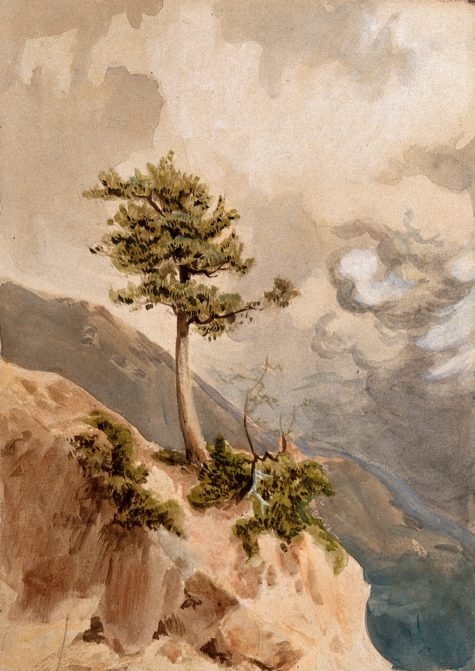
Juniper Mythology and Lore
Juniper was a symbol of the Canaanites’ fertility goddess Ashera or Astarte in Syria. In the Bible’s Old Testament, a Juniper with an angelic presence sheltered the prophet Elijah from Queen Jezebel’s pursuit. Similarly a later apocryphal biblical tale tells of how the infant Jesus and his parents were hidden from King Herod’s soldiers by a Juniper during their flight into Egypt.
Juniper plants are associated with protection in many different Native American tribes. The Interior Salish and Northwest Coast tribes used Juniper to banish evil spirits and protect themselves from witchcraft.
Among the southwestern Pueblos, junipers were believed to counteract ‘ghost sickness,’ a malady which afflicted bereaved relatives or people who handle the bodies of the dead.
Plains Indian tribes, such as the Dakota, Cheyenne, and Pawnee, often hung Juniper boughs on their tepees or burned them in the camp fire to keep their homes safe from storms.
And in many tribes people, especially hunters, would carry a spring of Juniper as a protective charm or rub Juniper branches on their bodies before embarking on a dangerous journey to protect themselves from grizzly bears, monsters, or general bad luck.
Juniper is one of the herbs frequently included in medicine bundles and amulets. Juniper berries were also eaten by people in some Southwestern and Southern California tribes, and Juniper leaves were frequently used as medicinal herbs.
Folk tradition records a divinatory significance to the appearance of Juniper in dreams, for:
- It is unlucky to dream of the tree itself, especially if the person is sick.
- To dream of gathering the berries, if it be in winter, denotes prosperity.
- To dream of the actual berries signifies that the dreamer will shortly arrive at great honors and become an important person.
- To the married it foretells the birth of a male child.
The largest body of folklore concerning Juniper comes from Iceland where it was traditionally believed that Juniper and rowan could not grow together because each creates so much heat that one or other of the trees would be burn up. For the same reason it was considered not a good idea to bring sprigs of both woods into the house together unless you particularly wanted your house to burn down.
Another Icelandic belief has it that if you are building a boat, you must either use both Juniper and rowan wood or use neither of them in the boat, otherwise it will sink.
In Wales it was said that anyone who cut down a Juniper tree would be dead within a year, while in Newfoundland it was believed that wolves and bears are repelled by Juniper wood and for this reason people who kept stock would ensure that Juniper wood was used in building enclosures or stockades in which livestock would be kept.
Also in Newfoundland it is believed that you will always find water under a Juniper tree, though this seems to contradict the natural history of Juniper which, as mentioned above, generally grows best on limestone or chalk soils which are usually well-drained.
The Story entitled Red Riding Hood in the book The Hero of Esthonia tells of a mother laying down Juniper branches and making the sign of the cross over them to protect her sleeping children from devils. In the story The Compassionate Shoemaker in the same book, the devil is defeated by being struck by a staff of Juniper.
In the Argonautica, Medea uses a freshly cut spray of Juniper to sprinkle her sleeping potion into the eyes of the serpent guarding the Golden Fleece.
- Meaning and history of the name Juniper:
From the Latin, juniperus which means “youth producing” or “evergreen.” During the Renaissance era, Junipers were used symbolically in art to represent chastity. Juniper has historically been used as both a boys and girls name, in fact Saint Juniper and Thornton Wilder’s character Brother Juniper are both male.

The Juniper Tree – A Story
“The Juniper Tree” is a German fairy tale collected by the Brothers Grimm. The text in the Grimm collection is in Low German and was originally written down by the painter Philipp Otto Runge. The complete story as originally written can be found over at Widdershins.
Here is a synopsis:
A wealthy and pious couple pray every day for God to grant them a child. One winter, under the Juniper tree in the courtyard, the wife peels an apple. She cuts her finger and drops of blood fall onto the snow. This leads her to wish for a child to be as white as snow and as red as blood. Six months later, the wife becomes gravely ill from eating Juniper berries and asks her husband to bury her beneath the Juniper tree if she dies.
A month later, she gives birth to a baby boy as white as snow and as red as blood. She dies of happiness. Keeping his promise, the husband buries her beneath the Juniper tree. He eventually marries again and he and his new wife have a daughter named Marlinchen (in some versions Marlene, Marjory or Ann Marie).
The new wife loves Marlinchen but despises her stepson. She abuses him every day, claiming that she wishes Marlinchen to inherit her father’s wealth instead of her stepson. One afternoon after school, the stepmother plans to lure her stepson into an empty room containing a chest of apples. Marlinchen sees the chest and asks for an apple, which the stepmother gracefully offers. However, when the boy enters the room and reaches down the chest for an apple, the stepmother slams the lid onto his neck, decapitating him.
The stepmother binds his head with the rest of his body with a bandage and props his body onto a chair outside, with an apple on his lap. Marlinchen, unaware of the situation, asks her stepbrother for an apple. Hearing no response, she is forced by her mother to box him in the ear, causing his head to roll onto the ground.
Marlinchen profusely cries throughout the day whilst the stepmother dismembers the stepson’s body and cooks him into a “blood-soup” for dinner. She later deceives her husband by telling him that his son stayed at the mother’s great uncle’s house. The husband unwittingly eats the “blood-soup” during dinner and proclaims it to be delicious. Marlinchen gathers the bones from the dinner and buries them beneath the Juniper tree with a handkerchief.
Suddenly, a mist emerges from the Juniper tree and a beautiful bird flies out. The bird visits the local townspeople and sings about its brutal murder at the hands of its stepmother. Captivated by its lullaby, a goldsmith, a shoemaker and a miller offer the bird a gold chain, a pair of red shoes and a millstone in return for the bird singing its song again. The bird returns home to give the gold chain to the husband while giving Marlinchen the red shoes.
Meanwhile, the stepmother complains about the “raging fires within her arteries”, revealed to be the real cause of her anger and hatred towards her stepson. She goes outside for relief but the bird drops the millstone onto her head, killing her instantly. Surrounded by smoke and flames, the son, revealed to be the bird, emerges and reunites with his family. They celebrate and head inside for lunch, and live happily ever after.
Sources:
- Encyclopedia of Herbology
- Plant Lore
- Trees For Life
- Witchipedia
- White Dragon
- Encyclopedia of Magickal Ingredients
- The Herb Stop Blog
- Magical Herbalism by Scott Cunningham
- Magical Aromatherapy by Scott Cunningham

- Latin Name: Thuja occidentalis
- Alternative names: Thuja, White Cedar
- Ruler: Sun, Venus
- Type: Evergreen Tree
- Magickal Form: Bark chips, Twigs and Branch tips, Essential Oil
One of the holiest of woods, cedar is considered feminine and receptive in nature. White Cedar (Arborvitae) denotes great beauty, majesty, and strength. It is highly protective when worn and draws money, good health, and well-being when burned. White Cedar (Arborvitae) wood and bark appear in spells where benevolent power is needed.
Add to love potions when strength is needed to overcome hardships. White Cedar (Arborvitae) opens up intuitive channels and brings forth compassion and humility. It is a true symbol of prosperity.
To move a person out without hurting him, cut three White Cedar branches, one three feet long and the others one foot long. Carry them to the person’s house and lay the long branch on the pathway, touching the front door and pointing to the street. Place the two short branches crosswise to this, at equal distances from each other to make a “double cross” shape. As you lay down the branches say: Now you will move by Faith (first branch). Hope (second branch). and Charity (third branch). Then walk away.
To rent a room put Arborvitae or White Cedar oil on the doorknob. People who come to see the room, will touch the doorknob and they will be more inclined to rent it.
To make the one you love follow you, wrap a fresh fig leaf tightly around a strip of White Cedar bark and wrap a leaf torn fro the Bible tightly around them both. Carry this on you, and your lover will follow you if you move.
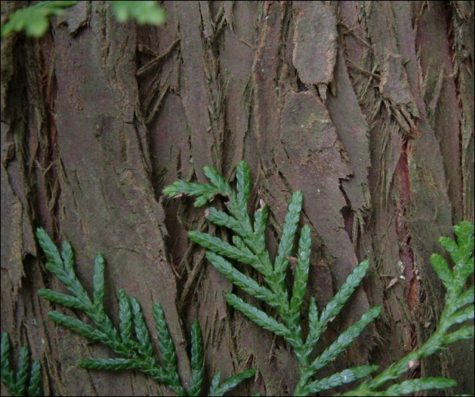
History and Lore
White Cedar (Arborvitae) is a tree with important uses in traditional Ojibwe culture. Honored with the name Nookomis Giizhik (“Grandmother Cedar”), the tree is the subject of sacred legends and is considered a gift to humanity for its myriad uses, among them crafts, construction, and medicine.
A nice native American story about the Cedar can be found here: The Story Of Cedar.
It is one of the four plants of the Ojibwe medicine wheel, associated with the north. White-cedar foliage is rich in Vitamin C and is believed to be the annedda which cured the scurvy of Jacques Cartier and his party in the winter of 1535–1536. There are some reports that the Ojibwa made a soup from the inner bark of the soft twigs.

Arborvitae Aromatherapy
Turn Arborvitae oil into a household spray with this easy do-it-yourself. Add a few drops of Arborvitae essential oil into a spray bottle and add water. Use this spray on surfaces or on hands. Arborvitae oil is a powerful cleansing and purifying agent. By incorporating this spray into your home, you can protect yourself and your family against seasonal and environmental threats while keeping your house fresh and clean.
Arborvitae essential oil has the ability to inspire feelings of peace and calm. If you are looking for a great way to unwind after a long day, place a few drops of Arborvitae oil into a diffuser or rub a drop of Arborvitae oil onto your wrists to produce a sense of peace and calm. Additionally, using Arborvitae essential oil during yoga or Pilates can increase the effectivity of your experience by inducing feelings of soothing relaxation. Diffusing Arborvitae essential oil can also help purify the air and provide a grounding aroma.
Bring your furniture back to life with this DIY Wood Polish with essential oils. If you want to keep wood looking fresh and clean, it is important to invest in proper cleaning supplies and a good routine. One of the most effective ways to clean wood is by using a wood polish that is natural and free of any harmful chemicals. Many commercial wood polishes contain chemicals and artificial fragrances that can cause irritation or health problems when not applied with proper safety precautions. Follow the instructions to this homemade solution to create a natural wood polish that is free of harmful toxins.
Wood furniture should only be polished every couple of months, but make sure to maintain the look and quality of your wood furniture by frequently dusting it or wiping it with a damp microfiber cloth. This will help to keep dust and damaging substances away from the wood and will help keep the wood from looking aged.
Create your own musky outdoor cologne with Arborvitae essential oil. Arborvitae oil’s aroma is woody and warm and when combined with Cedarwood and Frankincense, provides an invigorating aroma, perfect for a fresh cologne scent. Using these oils together will create a great cologne for any occasion and will also produce a fragrance that uplifts and relaxes the senses.
Arborvitae essential oil blends well with Birch, Cedarwood, Cassia, Cinnamon Bark, and Eucalyptus essential oils for diffusion.
Sources:
- Encyclopedia of Herbology
- Encyclopedia of Magickal Ingredients
- Hoodoo Herb and Root Magick
- doTERRA
- Latin Name: Juniperus virginiana
- Planet: Sun
- Element: Fire
- Part Used: Dried wood, essential oil
- Magickal Influences: Spirituality, Self-control
- Warning: Cedarwood oil should not be used by pregnant women.
Cedar has an important place in many cultures as a strong spiritual agent with a cleansing presence, a protective plant in rituals and as medicine. It is commonly ascribed similar properties as Sage; the needles, bark, or sap is burnt as an incense, the smoke it emits protecting and cleansing against spiritual “residue.” Cedar can be “smudged” like sage, to purify a space, home, or person.
In the ancient world, cedar from Lebanon was highly prized – so much so that only a few trees remain standing in that country. The name Lebanon is derived from the Akkadian word lubbunu, incense.
This was one of the most widely used incenses in the general Mesopotamian region and by the pre-contact Native American tribes.
There are few among us who aren’t familiar with the rich scent of cedar. Shavings of the wood are sold in pet supply stores. The characteristic smell of pencils stems from the red cedarwood used to produce them. And many of us have at least smelled a cedarwood chest. These are ideal for storing magickal supplies (everything, that is, except herbs and essential oils).
The fragrant, calming smoke when the wood burns is believed to allay nightmares, night terrors, hauntings, malevolent influences/thought forms, evil spirits, and ill-meaning wild animals. Many native peoples in North America use the smoke to cleanse a home; in the Native-Hispanic traditions, home-cleansings are called “limpias,” and Cedar wood being favored in this way. Again, the smoke of Cedar is used to purify the body, not just the home.
Two main cedarwood essential oils are available. Because the essential oils share similar constituents, Atlas Cedarwood (Cedrus atlantica) or Red Cedarwood (Juniperus virginiana) can be used with equal effectiveness in magickal aromatherapy.
The scent of the wood and the essential oil promotes spirituality. Inhale this sweetly antiseptic, calming fragrance before religious rituals to deepen your connection with Deity.
It’s spiritual qualities make the fragrance of cedar ideal for bringing ourselves into balance. Smell the aroma and visualize yourself as poised, calm, and in control of your own life.
Many Cherokee descendants carry a small piece of cedar wood in their medicine bags worn around the neck for protection. In a legend of the cedar tree told by the Cherokee Indians, the trees literally hold spirits of their ancestors, and they believe the wood carries powerful protective spirits. It is told that the Creator placed the spirits of their people in a newly created tree which makes it a very special tree indeed.
In another old Indian legend, a young hunter has a vision of a redheaded woodpecker that teaches him how to make the flute from a red cedarwood tree; the young hunter uses his flute as a love charm to win his wife, who was the daughter of a big and powerful chief of the village.
It made its way into folklore; bringing good luck and good fortune, health and healing, cedar was burned to invite positive energy, happiness, harmony and peace. Cedar chips or shavings were burned to purify the vibrations of your sacred area and house, driving out all negative entities. Fresh cedar boughs are used as brooms for purification, exorcisms and to cleanse temples.

Superstitions and Lore
The Eastern Red Cedar is a slow growing tree and lives to be very old. It gets its name, grave yard tree, because of an old superstition that says, when a red cedar you planted grows tall enough to shade your grave, it will be time for you to die.
Never transplant a Cedar tree, it is bad luck. If you do transplant a Cedar tree and it dies, you will die soon thereafter.
In the Medieval Christian tradition, a cedar trees (along with elder trees) were thought to possibly have been used to make the cross that Jesus was crucified on, for this reason it was considered bad luck to burn cedar. It was also believed that Cedar brought poverty, so it was not a good idea to put one in your yard.
On the other hand, if a Cedar tree comes up on your land, don’t cut it down. As long as that tree flourishes, your family will have good health.
The Arabs referred to the older Cedars of Lebanon as “saints” and believed that he who injured one would be overtaken by evil.

Some Thoughts About Red Cedar
From the Iowa Herbalist here are some interesting thoughts about the Eastern Red Cedar:
I always find it interesting and thought-provoking when the spiritual and emotional effects of plants reflect their physical ones. Just as Cedar seeks to purge our bodies of spiritual impurities, or to protect a home from negative influences, the hard reality is seen at work when Cedar is taken as medicine: whether it is expelling mucus from our lungs as a stimulating expectorant, clearing them of bacterial or viral infection; or opening up our pores in a cleansing fever to clear toxins, as invoked and adopted by sweat ceremonies. Whether you believe in esoteric herbalism, or not, Cedar does one thing: it cleans us, in mind and body.
Now, when I take that mind-transporting whiff of Cedar smoke, I realize why I felt that way. This beautiful tree’s magic is powerful. If you ever need a friend in the midst of illness, or during a hard emotional time, or if you just need to get some bugs out of your system– Cedar is your herb.
If you wish for simpler times, are feeling nostalgic or just want to reminisce, no plant can summon that feeling better; taking you far up into a cabin in the mountains, surrounded by pines and firs, and blankets. Enjoy it in a tea, your favorite elixir, a tasty syrup or perhaps in a calming incense blend. I remember such effects when I’m winding in between the rust-colored Eastern Red Cedars, peppered across Iowa’s tawny grasslands in winter, harvesting their little blue cones. Each time I bring in a jar or two, I spread some of the berries in places where Cedars don’t grow– to make sure there are more trees there for us to enjoy in the future. It’s my way of saying: “Thank you.”
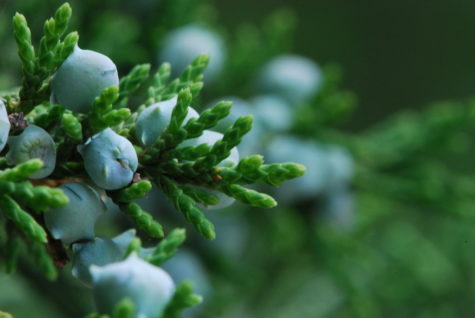
About Juniper
Because Red Cedar is a Juniper plant, the following also holds true.
Juniper, particularly through her wood and berries, is an absolutely wonderful tree with a wide range of uses. In terms of overall meanings in a North American context, we might summarize with the following:
Juniper is about warmth and fire. Juniper helps warm people up and is a strong fire-dominant tree, suggesting many associations with fire: passion, energy, warmth, and the sun.
Juniper offers hope in dark times. Juniper’s berries have long been a staple through the darkest of winters, and I see this both physically and metaphorically. Culturally, we are in a period of darkness, and trees like Juniper can help see us through.
Juniper offers regeneration and bringing things back. Juniper’s ability to grow in places few other trees can demonstrate that this tree is a true land healer, offering us hope in these dark times and sharing the critical message of the healing power of nature. I also think this is tied to its sympathetic magick uses in the American magickal traditions–Juniper helps bring things back.
Sources:
- Encyclopedia of Herbology
- Locusts and Honey
- Magical Aromatherapy by Scott Cunningham
- Iowa Herbalist
- Encyclopedia of Superstitions
- Druid’s Garden
- Latin Name: Ilex aquifolium, Ilex opaca (American Holly)
- Celtic name: Tinne (pronounced: chihn’ uh)
- Known as: Tree of Sacrifice
- Folk or Common names: Holly, Aquifolius, Bat’s Wings, Christ’s Thorn, Holm Chaste, Hulm, Hulver Bush, Scarlet Oak, Kerm-Oak, Holy Tree
- Meanings: Holly actually means “holy”.
- Ruling Planets: Mars and Saturn
- Element: Fire
- Ruler: Sun
- Stone: Ruby, Bloodstone
- Birds: Cardinal, Starling
- Color: Red
- Deity: Lugh, Tannus, Thor, Danu
- Other: The Holly is an evergreen tree.
- Magickal Form: Wreaths, berries, leaves, wood
- NOTE: Holly berries are poisonous!
- Powers: Protection, Anti-Lightning, Luck, Dream Magick
Holly, being evergreen and having red berries, is a symbol of enduring life, and consequently it is considered a lucky plant almost everywhere. It is very unlucky to cut down a Holly tree.
The Holly Tree is one of the Seven Chieftain Trees of the Druids, its very name means “holy.” A Christian myth says that the blood of Christ formed the red berries of the holly. Holly is also associated with unicorns, since the unicorn is one of the Celtic symbols for this tree – the other symbol is the Flaming Spear.
Holly berries represent the blood of the Goddess. Use Holly berries with your favorite spell for female fertility and sexuality. Holly tames wild beasts and wards off storms and bad weather. Since it is a masculine herb, it brings good luck to men. The Romans considered Holly sacred and used it as a decoration during their Saturnalia celebrations.
Holly is sacred to the Winter Solstice, when it is used for decorating. Decorating one’s home with holly was believed to bring protection and good luck to the inhabitants in the coming year. Holly was used for decoration throughout homes with it being used for boughs over entrances to peoples’ homes or formed into holly wreaths that were hung on doors.
Sprigs of holly in the house at Christmastime will bring you good luck. But… be careful not to bring it indoors before Christmas Eve or your family will fall to squabbling. (Bet you wondered why that happened. grin…) Also be sure to burn it on 12th night (January 5th) or the good luck will turn sour.
Holly was the gift of good luck among the Romans celebrating their midwinter festivals. The northern tribes, who eventually brought about Rome’s downfall draped holly over doorways as shelter for friendly woodland spirits who could bring good luck to their houses.
The custom of bringing holly boughs into the home in the depths of winter has its origins in the original pre-Christian idea that its prickly leaves sheltered the fairy folk, who were delighted to come indoors at such a cold time of the year.
The wreaths are very popular around the Christmas / Yuletide season. Placing a ring of holly on doors originated in Ireland since holly was one of the main plants that was green and very beautiful with its red berries at this time of year and gave poor people a means of decorating their dwellings.
Unlike mistletoe, it appears in the Christmas Greenery of churches as well as ordinary houses. In some districts, when the rest of the decorations are burnt or thrown away at the end of the holiday, a holly-sprig is kept, to protect the house from lightning during the coming year.
- Planted near a house, holly repels negative spells sent against you.
- A bag of leaves and berries carried by a man increases his ability to attract women.
- Burn Holly leaves with Blessing Incense to protect the home and draw good luck.
- Place Holly above the door lintel for protection and to invite helpful spirits.
- Carry Holly berries in your pocket for protection.
The Holly tree (of which there are well over 150 species) can grow (albeit very slowly) to be as high as fifty feet and is native to most of Central and Southern Europe. Its white, star-shaped flowers bloom in the Spring and it bears shiny red berries in Autumn which last throughout the Winter season. The leaves of the Holly are shiny, dark green in color, elliptical in shape and have spiny points. In order to produce berries, both a male and a female tree are required. Only the female tree produces berries which, although lovely to look at, are poisonous.
Given its evergreen nature, the Holly represented immortality and was one of the Nine Sacred Woods used in Need-Fires (the others being Oak, Pine, Hazel, Juniper, Cedar, Poplar, Apple and Ash). In ancient Irish lore, it was also listed as one of the Noble Trees of the Grove (along with Birch, Alder, Willow, Oak, Hazel and Apple).
The Holly tree has a fine white wood which was once used in the making of inlays and for walking sticks as well as riding crops. Its leaves are a favorite food among deer and sheep during the Winter months. The wood of the Holly is hard, compact and beautifully white in color, being susceptible of a very high polish.
Magical History and Associations:
Each month of the Celtic Lunar calendar bears the name of a tree. Holly is the 8th Moon of the Celtic Year – (July 8 – Aug 4).
The Holly, a masculine herb, is associated with the element of fire, and is an herb of Saturn and Mars. The bird associated with this month is the starling, the color is green-gray, the gemstone is yellow caingorm, and the day of the week association is Tuesday. Holly is the first moon of the dark half of the year, and the Holly is sacred to both the Winter and Summer Solstices.
Summer Solstice is the time when in mythology, the Oak King is slain by his twin, or tanist, the Holly King, who rules until the Winter Solstice, when he in turn is slain by his tanist, the Oak King. Tanist is related to the tannin found in an Oak tree; Oak and Holly are two sides of the same coin, the end of one cycle and the beginning of the next.
Holly is one of the three timbers in the Chariot Wheel. It represents personal sacrifice in order to gain something of greater value.
The Holly is also sacred to the deities of Lugh, Habondia, Tina Etruscan and Tannus. There are special spirits that dwell within Holly trees: the Holly Man lives in the tree that bears prickly Holly, and the Holly Woman dwells within that which give forth smooth and variegated leaves.
Magickal usage:
The month of Holly is a good time to do magick designed to help bring about a successful harvest. The Holly has applications in magick done for protection, prophesy, healing, magick for animals, sex magick, invulnerability, watchfulness, good luck, death, rebirth, Holiness, consecration, material gain, physical revenge, beauty and travel.
Dreaming of Holly means you should be mindful of what is troubling you, and picking holly in your dreams means you will have a long life.
Holly also has the ability to enhance other forms of magic. As a symbol of firmness and masculine energy, Holly wood was used by the ancients in the construction of spear shafts, which were thought to then have magickal powers. Uses of Holly in protective magick includes hanging a sprig of Holly in the home all year to insure protection and good luck. Holly is also an excellent charm to wear for protection.
‘Holly Water’ can be made by soaking Holly overnight in spring water under a full moon. This water can then be sprinkled over infants to keep them happy and safe. Holly Water can also be used to sprinkle around the house for psychic cleansing and protection.
A “par excellence” protective herb, it protects against lightning, poison, and evil spirits. When thrown at wild animals it makes them lie down quietly and leave you alone. Holly leaves can be cast around outside to repel unwanted spirits or animals and a Holly bush can be planted close to houses to protect against lightning. Ensure that the Holly has a place in your garden because its presence wards off unfriendly spirits. Do not burn Holly branches unless they are well and truly dead, for this is unlucky.
Holly is considered the male counterpart to the female Ivy. Holly, intertwined with ivy, is traditionally made into crowns for the bride and groom at weddings/handfastings. Holly and Ivy also make excellent decorations for altars.
Holly is also a traditional decoration for Yuletide as in sung in the traditional Yuletide song:
“Deck the halls with boughs of Holly,
fa la la la la, la la la la.”
Even though Holly’s Yule festival greens are traditionally burned at Imbolg, a small sprig us kept for luck and to keep evil away throughout the year. Holly berries were used to predict winter weather. If there were a profusion of berries, that meant it would be a hard winter, because the Goddess was providing extra berries for the birds.
When harvesting the leaves from the Holly, remember to ask the tree if it will allow you to take the parts and be sure to leave the tree an offering of thanks when you are done. Holly favors red and yellow stones as gifts.
A north country charm to induce dreams of a future mate required the seeker to go out in silence at midnight on a Friday, and gather nine she-holly leaves (the smooth variegated variety). These had to be tied with nine knots in a three-cornered handkerchief, and laid under the pillow before going to bed. The future husband or wife would appear in a dream, but only if complete silence had been preserved from the moment of setting out to gather the leaves until dawn the next day.
The Deeper Meaning of Holly
It is during June that the light of the sun reaches its culmination, and then begins its descent into earth. The Holly speaks to the fierce capacity of the human soul to take the descent into the underworld, bringing inner light into darkness. Thus we can understand the signature of the tree, with its ability to germinate without sunlight, favoring dark, moist conditions that are more strongly related to the downward earth pole. Its stiff, pointed leaves are not unlike thorns or “spears.”
The Holly yields a hard, white close-grained wood that imparts a quality of solidity and impermeability, as it stands in the depths of winter, impervious to cold and darkness with its somber evergreen color.
The Druid initiates developed a sacred alphabet, called the Ogham, based upon the archetypal qualities of trees. The Holly, known in Gaelic as Tinne ruled the eighth moon of the year, or the month of June. The glyph for Holly is that of a spear, meaning literally, “I am a battle-waging spear.”
Of all the trees in the Ogham, the Holly and the Oak are most primordial—they are viewed as two “kings” who exchange leadership on a yearly basis by engaging in symbolic battle. The Gaelic name for Holly—Tinne—is related to the word, tanist, meaning “dark twin.” The Oak King rules from the time the light begins its ascent in December until the summer solstice in June. Holly is the “dark twin” who reigns during the waning light of the year, until winter solstice.
The Holly’s prominence at Christmas is actually meant to represent a culminating experience within the soul life. It is an awakening of the love forces of the heart achieved through a descent into the interior of the self and the earth that comes to fruition during this festival. This understanding is depicted in Rudolf Steiner’s Calendar of the Soul.
Steiner is a modern initiate who incorporated the mystery streams of earlier cultures, including Druidic wisdom. His calendar is a series of 52 runic verses for each week of the year. Beginning at summer solstice, the soul gradually finds its way into an interior reality, moving out of the great cosmic heights. The sense of self coalesces like a seed, with light working into the inmost being, as a purifying and strengthening force. Then, at winter solstice, this light is quickened and shines forth from the heart chakra:
To carry spirit light into
World Winter-night
My heart is ardently impelled
That shining seeds of soul
Take root in world ground
And the Holy Word resounds
Through the darkness of the senses
Transfiguring all life.
In subsequent winter verses Steiner describes this activity of the soul as a “heart-high gladness”. It is the inner light of Self-containment gained by living in “spirit depths”—at one with the “world ground.” The soul is so solidly secure and anchored within itself that nothing can assail one’s sense of deep peace. When this consciousness is mastered, the journey inward of the Self is complete. The heart awakens with a streaming of love, gradually seeking its way outward into the sense world again to meet the expansive forces of the light in spring and summer.
We could say that the Holly flower which blooms in outer nature in late spring/summer, blossoms again in the human heart during winter as a force of love. Its nature is a sun force that lives, not in the heights but in the depths of the earth.
Perhaps the most profound archetypal picture of Holly is evoked through its symbolism as the Crown of Thorns. As the traditional Christmas carol proclaims, Of all the trees that are in the wood, the holly bears the crown.
Druid priests wore Holly in their hair while collecting the sacred mistletoe medicine in the winter, Holly was also worn as a crown to represent the Holly King in seasonal festivals. The Holly Crown was a sign of deepest respect and recognition that such an initiate had mastered the forces of nature in harmony with the human soul.
The Holly tree came to be known as Christ-Thorn in middle Europe, for it was recognized that this plant spoke to the archetypal reality of the Crown of Thorns as a soul initiation. The Crown of Thorns is also a kind of “beheading.” The false self must be pressed down with a Crown of Thorns until it finds a deeper truth in the human heart. The “battle waging spear” is thrust not outside, but within.
Holly teaches us that we cannot find love outside ourselves, if it is not anchored from within the human heart. Holly creates what is divine from within what is human. Holly helps the human heart know its own wholeness; its own holiness.
Herbal usage:
The powdered leaves were brewed into a healing tea for measles, fevers, bladder problems and bronchitis, and the ashes from burning the leaves in a drink soothed whooping cough.
Hot compresses made from the leaves and bark helped ease the pain of broken bones and dislocations. The juice of the fresh leaf is helpful in jaundice treatment. Holly can be used homeopathically as a substitute for quinine.
Note: Holly berries are poisonous!
Holly Folklore and Superstition
Male, or prickly, holly is lucky to men, as the smooth variegated type, known as the she-holly, is to women. If the First Foot on his rounds brings evergreens with him, it is usually holly that he chooses, but in this case it must be the male kind, for the other variety, being female, would be very ill-omened.
Holly branches must never be burned when green. To do this is extremely unlucky, and may cause a death in the family. It is also unlucky in some places to stamp on a holly berry, or to bring the plant indoors when it is flowering.
A well-known country remedy for chilblains is to thrash them with a holly bush “to let the chilled blood out.” This probably does some good by restoring the arrested circulation, but the choice of holly rather than anything else as a thrashing agent is made for magickal reasons.
Sources:
- Holly The Heart Healer
- Encyclopedia of Magickal Ingredients
- dutchie.org
- Encyclopedia of Superstitions
According to the Celtic mythology of trees, Mistletoe is the tree of the day after the Winter Solstice (Aprox. December 23). In Druidic lore Mistletoe is an herb of the Winter Solstice and is the special plant for the day after Yule.
- Latin name: Viscum Album
- Celtic name: It is said that Mistletoe is too sacred to have a written word.
- Folk or Common names: Donnerbesen, Birdlime, All Heal, Golden Bough, Devil’s Fuge, Thunderbesom
- Parts Used: Leaves, berries, twigs
- Basic Powers: Protection, Love
Mistletoe is a plant of the sun and also of the planet of Jupiter. It is associated with the element of the air. The colors of Mistletoe are green, gold and white, and its herb is hyssop. The gemstones associated with Mistletoe are Black Quartz, Amber, Pearl and green Obsidian. Mistletoe has the immortal creature the Gryphon-Eagle associated with it and also the plain eagle is its bird association. There are many deities associated with Mistletoe: Loki, Blader, Hercules, Shu, Osirus, and Aeneas are a few of those deities.
Magickal usage:
Romans, Celtics, and Germans believed that mistletoe is the key to the supernatural. Mistletoe will aid and strengthen all magickal works but is best called upon for healing, protection, and beautiful dreams – dreams which will unlock the secrets of immortality. Mistletoe is a good wood to use for making wands, other ritual tools and magickal rings.
The Berries are used in love incenses, plus a few berries can be added to the ritual cup at a handfasting. Boughs of Mistletoe can be hung for all purpose protection around the house. Sprigs of Mistletoe can be carried as an herb of protection – plus amulets and jewelry can be made out of Mistletoe wood as protective talismans.
Hung over the cradle, Mistletoe will protect the child from being stolen by the fey and Mistletoe that is carried will protect the bearer from werewolves. Mistletoe stood for sex and fertility – hence our tradition of kissing under the mistletoe. It is traditionally hung in the home at Yule, and those who walk under it exchange a kiss of peace.
Pick on Midsummer’s Eve, or when the moon is six days old (six days after the New Moon). Wear as a protective amulet, or to help conceive. The wood is often carved into rings and other magickal objects. A good anti-lightning charm. The herb hung anywhere is an excellent all-purpose protective device. Extinguishes fire. Wear as an amulet to preserve against wounds.
Kissing Under the Mistletoe:
Kissing under the mistletoe seems to be a purely English custom, of which no trace has been found in other countries unless Englishmen have settled there at some time. Strange as it may seem to us now, the English were once much given to kissing. Foreign visitors in the 16th and 17th centuries frequently remarked with surprise on the way in which men and women exchanged kisses without self-consciousness, even slight acquaintances and newly-introduced strangers being thus pleasantly greeted.
The last shadow of this old freedom is now cast by the mistletoe bough at Christmas. If a girl stands under it, she cannot refuse to be kissed by anyone who claims the privilege. At one time, the young men had the right to pluck a berry from the bough for every kiss they took.
It was also thought that if a girl was kissed seven times in one day under the mistletoe, she would be married within a year. A girl who stood under the mistletoe but did not receive a kiss was doomed to remain without a husband for at least one year. A girl who gets married without ever having been kissed under the mistletoe will never have children.
Kissing under the mistletoe is not only for lovers. You should kiss anyone and everyone possible while the mistletoe is hanging. This brings good luck to everyone in the house for a whole year.
Magical History:
Mistletoe, the Golden Bough of classical legend, was a sacred and wonder working plant alike for the Celtic Druids, by whom it was ceremonially cut at the Winter and Summer Solstice festivals. Mistletoe is one of the Druid’s most sacred trees – as Ovid said, “Ad viscum Druidae cantare solebant.” (The Druids are wont to sing to the Mistletoe.).
The Druids gathered their Mistletoe at Midsummer or at the 6th day of the moon. The Druid priests or priestesses would wear white robes while gathering the plant and would use a golden knife to cut the plant from the tree.
The mistletoe was caught in their robes to prevent any from falling to the ground, where it would lose its magickal qualities, and so extreme care was taken not to let the plant touch the ground. Two oxen were often sacrificed for the harvest. The Druids considered that the Mistletoe that grew on Oak trees was the most potent and sacred.
For the Norsemen, it was the holy and terrible plant which slew Baldur the Beautiful when all things in Heaven and Earth had sworn not to harm him. But the mistletoe was forgotten because, rooting on trees and not in the ground, it was not in Heaven or Earth, but only between them. Consequently Loki, the trickster, was able to use it to kill the Dun God when all other things had failed him.
It was also the plant of peace in ancient Scandinavia. A bunch hung outside a house denoted a safe welcome within, and if enemies happened to meet under a tree that bore it, they had to lay down their arms and fight no more on that day.
It is said that if a branch or sprig of the mistletoe was cut with a new dirk on Halloween, after the cutter had walked three times round the oak sunwise, it was sure guard in the day of battle, and a protection at all times against glamour and witchery. A similar sprig laid in the cradle protected the child from being stolen by the fairies and replaced by a changeling.
Being a thunder-plant, its presence in a house protected it from thunder and lightning, as well as from witches and evil spirits. In Britain, it was anciently called All Heal, because it cured many diseases, composed quarrels, and was an antidote to poison. It brought good luck and fertility. For all these reasons it was, and remains, an essential part of Christmas decorations in almost every house, though not in churches.
Its strong pagan associations probably caused it to be banned from churches at Christmas or any other season. This prohibition still prevails in most parishes, and if a sprig or branch is accidentally included in the general greenery, it is usually removed as soon as the clergyman sees it. In one Oxford parish several years ago, permission was given to hang a bunch in the porch, but not inside the church itself.
An exception to this rule in the Middle Ages was at York Minster, where a branch was ceremonially laid on the altar on Christmas Eve and left there throughout the Twelve Days of Christmas. A general pardon and liberty throughout the city was proclaimed for so long as it remained there.
In Worcestershire, where it grows very freely, it is said to be unlucky to cut mistletoe at any time but Christmas. Until very recently (and perhaps still in some households), it was usual to keep the Christmas bunch throughout the year for good luck, and then to replace it by a new one on Christmas Eve.
In some districts, sprigs from such a bunch were given to the cow that calved first after New Year’s Day, to ensure the prosperity of the herd in the following twelve months. In Herefordshire formerly, it was unlucky to bring mistletoe into the house before New Year’s morning. It was not included in the Christmas decorations, but was brought in at the time of the Burning the Bush.
To cut down a mistletoe-bearing tree was once considered to be very unlucky. Many stories are told of misfortunes which fell upon those who did so.
A curious tradition relating to the Hays of Errol, in Perthshire, is connected with this idea. The continued existence and prosperity of that family was bound up with an ancient mistletoe-bearing oak growing near the Falcon Stone. So long as the tree stood and the mistletoe grew on it, they would flourish, but, as we read in the verses traditionally ascribed to Thomas the Rhymer,
… when the root of the aik decays,
And the mistletoe dwines on its withered breast,
The grass sall grow on Errol’s hearthstone,
And the corbie roup in the falcon’s nest.
Oak and mistletoe together have vanished now, and the estate no longer belongs to the Hays. Exactly when the tree was cut down is not now remembered, but local tradition says that it was before the lands were sold, and that it was because of that destruction they were lost to the family.
Herbal usage:
CAUTION: Mistletoe berries are extremely poisonous and have been known to cause miscarriage.
Mistletoe tea was widely believed to cure the falling sickness or epilepsy, and is still recommended by herbalists for that purpose. The plant was also used in folk-medicine for a variety of other ills, including St Vitus’ Dance, heart troubles and nerve complaints, sores, the bites of venomous creatures, and toothache.
Mistletoe can be used as a stimulant to soothe muscles and to produce a rise in blood pressure. It increases the contraction of the uterus and intestine. Mistletoe has been recommended as an oxytocic in postpartum hemorrhage and menorrhagia. It is also used as a circulatory and uterine stimulant. This plant can induce menstruation. It has shown effective in treating tumors in some animals. It is recommended that due to the toxicity of this plant that ingestion of this herb be avoided.
Sources:
- Magickal Herbalism
- Encyclopedia of Superstitions
- Dutchie.org
- Ruler: Saturn
- Type: Tree
- Magickal Form: Branch and Leaves
- Meaning: Complete change in life-direction or attitude
This is a dark tree, ruled by the Crone. It is used in spells to raise the dead. Yew is also used in ritual to help make the transition into menopause. According to Celtic tree mythology, the Yew is the tree of the day before the Winter Solstice (Approx. December 21).
- Latin name: Taxus baccata.
- Celtic name: Idho (pronounced: Ih’ huh).
- Folk or Common names: English Yew.
The evergreen yew, which lives to an immense age, extending over many generations of men, is a natural symbol of life everlasting, and seems to have been so regarded from time immemorial, alike by pagans and by Christians.
Because of its great longevity, the yew is a symbol of everlasting life. It grows in an unusual way, too, its new stems growing down the outside of the tree, giving the yew an association with rebirth and regeneration, as the new is born from the old. Adding to this symbolism is its habit of putting in a growth spurt when it is around 500 years old.
So sacred was the yew as a symbol that – to a pre-Christian society – wherever it grew was considered to be sacred ground. It was considered both immoral and illegal to chop down the tree. It is likely that the yew is often seen in churchyards because the church itself would have been built on this sacred ground in the presence of the tree, in an effort to align the incoming Christian belief system with pagan traditions.
The association of the tree with death therefore started to overlay its former meaning. Because the berries of the yew are poisonous, they can effectively carry people into the spirit world.
At English country funerals formerly, the mourners often carried branches of yew, which they laid with the dead man in the grave. Small sprigs were also inserted in the folds of his shroud in some districts, before the coffin was nailed down. These typified, not the end of life, but its continuance in the resurrection to come.
Similarly, yew-boughs are usually included today in church decorations at Easter, because they symbolize the triumph of life over death and so are fitting emblems of the Resurrection.
The hollow center of the yew tree is a symbol not only of the power that lies in empty space, but underlines the significance of this tree as belonging, in part, to a spiritual dimension. Recently, the yew as a symbol of life has been shown in a practical and unexpected way. One of the constituent chemicals of the tree, taxol, has been found to be efficacious in curing breast cancer.
Old Ideas About The Yew
In Elizabethan times it was considered an unlucky plant. The Elizabethans tossed sprigs of yew into graves to ensure that the spirits of the dead did not come back to haunt the living.
To cut down a yew tree growing in a churchyard, or to burn or damage its branches, is very unlucky. It is also said to be unlucky to bring yew branches into the house, and most people are careful to omit them from the evergreens used for Christmas decorations.
In the Scottish Highlands, in the days of clan warfare, there was a curious tradition which said that if a chief too a piece of churchyard yew in his left hand, and then denounced or threatened his enemy, the latter, though present, would hear nothing, though all around could hear quite clearly what was said. This presumably, enabled the speaker to claim afterwards that he had given due warning of his intentions, while at the same time retaining the advantages of a surprise attack on a totally unprepared victim.
Although at one time it was considered dangerous to carry a sprig or branch of yew into the home, in Herefordshire, a girl who wished to dream of her future husband went to a churchyard that she had never visited before and plucked a sprig, which she laid under her pillow at night. This would enable her to see her future partner in her dreams.
In the north-midland counties of England, lost goods could be found if the seeker took a branch of yew and held it out before him as he walked. He would be led straight to the place where the lost things were, and when he reached it, the branch would turn in his hand.
The yew is also renowned for protecting homes and other buildings from witches and evil spirits. It is believed that you are likely to die within twelve months if you trim or cut down a yew tree.
Magickal Associations of Yew
Bulls are associated with this tree, as are female goats. The bird associated with Yew is the eaglet, since the eaglet’s appetite is insatiable, and the bones of its nest are white like the snow on its cliff-ledge. The Yews colors are white and silver and it is associated with the element of water. The Yew is associated with the planet Saturn and with the metal lead. In Old England the Yew was known as “The Witches Tree” since it is associated with sorcery and magick.
Magickal usage:
The time of Yew is known as a time of death, and so on the day before Yule it said that is not a good idea to do actual spell work, instead it is suggested to do rituals of the season concerned with reincarnation. Because the Yew grows to such an old age, it has become a symbol of stability in Celtic areas of the world and so is often used as the central “World Tree” in ritual spaces.
As one of the three magickal trees (along the Alder and the Black Poplar) associated with death and funerals, the Yew has often been planted in graveyards. Yew sends up new trees from its roots, so is a powerful symbol of death and reincarnation.
Yew wood is appropriate for magickal tools such as wands and staves. In ancient times Yew sticks were carved with the Ogham characters as tools of divination. The Futhark features a 13th Rune, which is considered one of the most powerful Runes and represents a stave cut from a yew tree. This Rune is regarded as the stave of life and death. Yew can be dried and burned as an incense to contact spirits of the dead – and even to raise the dead.
If you are going to plant a Yew tree, it is best planted in the South-West corner of the property.
Magical History:
The name “Yew” is a corruption of the Anglo-Saxon word ‘eow’. The word ‘Taxus’ is from the Greek word ‘Taxon’, meaning ‘bow’. The 5000 year old “Ice Man”, discovered in the Alps, had a bow and axe handle made of Yew.
The Yew is known as the ‘Tree of Death’ through out Europe and is associated with the season of winter. It is sacred to many Dark Goddesses: Banbha, Amalthea (mother of the horned Dionysus), Morrighan, The Erinyes, Cailleach Beara, Berchta, and Hekate.
Shakespeare recognized the relationship of Yew and Heckate and referred to the contents of her cauldron as “slips of yew, silver’d in the moon’s eclipse…” (Macbeth) – and elsewhere Shakespeare makes ‘hebenon, the double-fatal yew’ the poison which Hamlet’s uncle pours into the king’s ear. Heckate’s sacred tree of death is said to root in the mouths of the dead and release their souls, and also absorbs the odors of death itself.
Yew wood is tough and durable and was used for making shields and spears, and also – using both heartwood and sapwood to gain extra strength – the famous English longbow that helped the English win the Battle of Agincourt in 1415, at which they were completely outnumbered. Hence the yew is also a symbol of the warrior.
Herbal usage:
This plant is poisonous and should never be ingested unless you are 100% sure that you know what you are doing. The needles and branch tips have been used to treat lung diseases and bladder problems. recently a new cancer drug, Taxol, has been derived from its bark and berries.
Sources:
- Encyclopedia of Magickal Ingredients
- Encyclopedia of Superstitions
- Element Encyclopedia of Secret Signs and Symbols
- Dutchie.org
- Acacia:
Symbolizes purity, air, and used in initiations, psychic workings, and protection. Also viewed as a Mother tree, the gum from it symbolizing menstrual blood. Tree of the wiccan goddess Neith, Osirus, Astarte, Ishtar, and Diana. Alder: Sacred to the god Bran. Represents resurrection, rebirth, and fire.
- Apple:
Used in love Magic and also for peace, happiness, prosperity, perpetual youth, and healing. Represents water. Associated with Venus, Hercules, Diana, Apollo, Hera, Athena, and Idunn.
- Ash:
Represents water, the Universal Mother, and the source for unborn souls. Used in healing, protection, and sea Magic. Traditional Yule log. Associated with Poseidon, Neptune, Woden, Thor, and Mars.
- Aspen:
Used for phyllomancy which is divination by leaf rustling. Used for protection.
- Birch:
Sacred to Cerridwen and represents beginnings and births. Used for purifications and blessings.
- Cedar:
Used for purification, prosperity, and longevity. Represents earth, spirituality and self.
- Cypress:
Used for Maypoles, easing losses, healing, past life workings, and protection. Represents earth.
- Elder:
A witch tree and often used to make wands. Used for healing, love, protection, and. Sacred to the goddess Hel. Represents air. Associated with Venus.
- Elm:
Represents primordial female powers. Used for protection.
- Fir:
Symbolizes youth and vitality. Used in prosperity magic.
- Hawthorne:
Called the May tree. Represents water and the White Goddess Maia. Used for female sexuality, cleansing, marriage, love, and protection.
- Hazel:
Sacred to witches and the Celtic sea god Manannan. Often used to make all-purpose wands and used in fertility, divination, marriage, protection, and reconciliation. Symbolizes female wisdom and air. Associated with Artemis and Diana.
- Holly:
Represents fire. Used for protection.
- Linden:
Used for prophesies and protection.
- Maple:
Used for love and divination.
- Oak:
Used for healing, strength, protection, masculinity and for fertility magic. Represents fire. Associated with Dagda, Dianus, Jupiter, Zeus, Cybele, Rhea, Janus, Cernunnos, and Herne.
- Palm:
Metaphor for Osiris’s penis. Used for male fertility, strength, and virility.
- Pine:
Symbolizes immortality and represents earth. Pine cones represent fertility. Used for purification, health, fortune, fertility, and prosperity. Associated with Pan, Attis, Venus, and Cybele.
- Rowan:
Used for protection, healing, and strength. Represents fire.
- Willow:
Represents water. Used in moon, wishing magic, healing, protection, enchantments, and easy delivery of babies. Associated with Artemis, Persephone, Hecate, Ceres, Hera, and Circe.
Source: Unknown
According to Celtic tree mythology, the Silver Fir is the tree of the day of the Winter Solstice. The Winter Solstice. This usually takes place on December 20th or 21st, although it does sometimes occur on the 22nd or 23rd (check your calendar as it changes from year to year).
- Latin name: Abies alba.
- Celtic name: Ailim (pronounced: Ahl’ em).
- Folk or Common names: Common Silver Fir, Balm of Gilead Fir, Balsam Fir, American Silver Fir.
- Parts Used: Needles, wood, sap
Magical History and Associations:
The Silver Fir is associated with the moon and with the planet of Jupiter. Its colors are piebald and light or pale blue. Its birds are the eagle and the Lapwing, and its animal association is the red cow. Its stones are Tourmaline and Amber – and it is a feminine herb. This tree belongs to the triple aspect Goddess in Celtic lore, offering learning, choice and progress. The tree is sacred to many Goddesses: Artemis (the Greek Goddess of Childbirth), Diana and Druantia among them. It is also sacred to the Gods Osiris and Attis, both who were imprisoned in Fir/Pine trees.
Magickal usage:
Burn to cleanse a room of negative vibes. This is a wonderful incense for healing and strengthening the physical, emotional, and spiritual body. The scent opens the heart and increases endurance.
The Silver Fir is used for magick involving power, insight, progression, protection, change, feminine rebirth, and birth. The Silver Fir and the Yew are sisters standing next to each other in the circle of the year and their foliage is almost identical. However the Yew is known as the tree of death and the Silver Fir is the tree of birth or rebirth. The Silver Fir was a sacred tree to the Druids who felt that it stood for hope. The Silver Fir wood is used for shape-shifting and magic involving change, since it offers a clear perception of the present and the future.
The wood chips are sometimes used as incense and the wood can be used in the construction of magickal musical instruments. Burning the needles of the Silver Fir or sweeping around the bed with a branch that has been blessed will protect a new born baby and its mother. In the Orkney area of Scotland, the new mother and baby are ‘sained’ by whirling a fir-candle three times around her bed.
For a ‘Weather Witch’ the cones of the Silver Fir warn of wet weather and foretells when a dry season approaches. Charms made of Fir can be given as good luck tokens to departing friends. In its appearance (and in its current, and undoubtedly ancient, use) the Silver Fir is the quintessential Yule tree. Its branches can be used as decorations at Yule time either as wreaths or as garland, where it will provide protection for the household and its occupants.
Recommended Reading:
- Year of Moons, Season of Trees
- Tree Medicine Tree Magic
- A Druid’s Herbal
- Celtic Astrology
- Glamoury: Magic of the Celtic Green World
- The Book of Druidry
Source: Dutchi.org
The Poplar or Aspen is the sacred Tree of the Fall Equinox – (Aprox. September 22).
There is a bit of confusion about poplar, aspen, and cottonwood trees. The tree referred to here is the genus “populus” which includes true poplars, as well as related trees such as cottonwood and aspen).
Here’s a quick list:
- Balsam Poplar (Populus balsamifera)
- Eastern Cottonwood (Populus deltoides)
- Bigtooth Aspen (Populus grandidentata)
- Black Poplar (Populus nigra)
- European Aspen (Populus tremula)
- Quaking Aspen (Populus tremuloides)
- Black Cottonwood (Populus trichocarpa)
As far as I could discover, the Aspen and Poplar tree magickal lore overlap, and can be used interchangeably, unless otherwise indicated. The lore does not refer to the Yellow Poplar (Liriodendron tulipifera), or Balm of Gilead (Populus candicans) which have different attributes and magickal qualities
- Celtic name: Eadha (pronounced: “Eh’ uh”).
- Folk or Common names: All Poplar – Popple, Alamo, Aspen; Trembling Poplar – American Aspen, White Poplar, or Quaking Aspen; Balm of Gilead – bombagillia.
Magickal Usage:
- Ruler: Saturn
- Type: Plant
- Magickal form: Buds
Carry poplar buds with you when seeking employment. Crush and add them to traditional money incense when you work on commission and need to attract more funds. The poplar buds may also be added to divination blends and make a great ingredient for psychics wishing to attract more business, as well as improving their powers.
The Poplar’s ability to resist and to shield, its association with speech, language and the Winds indicates an ability to endure and conquer. The Poplar is known as the “Tree that Transcends Fear”. Poplars symbolize the magick of joy, the aging of the year, resurrection and hope – and are connected to the Otherworld. Poplar can be used in magick done for success, passage and transformation, Hope, rebirth, divinations, shielding, endurance, agility in speech and language, protection, and love – and as an aid in astral projection.
Poplar can be used in protection charms of all kinds. Poplar is a good wood to burn in balefires and ritual fires since it offers protection. Shields can be made of Poplar since the wood is thought to offer protection from injury or death. Carrying Poplar helps to overcome the urge to give way under the burden of worldly pressures, and aids in determination. Poplar buds can also be carried to attract money and can be burned as an incense to create financial security.
Siberian reindeer-hunting cultures carved small goddess statues of Poplar (Aspen) wood. Groats and fat were then offered to the figures with this prayer:
“Help us to keep healthy!
Help us to hunt much game!”
Poplar buds are also sometimes added to flying ointments and was also used in astral travel. A medieval recipe for a flying ointment called for Cinquefoil, Poplar leaves, soot and bat’s blood obtained at the wake of the new moon.
The trembling leaves of the Poplar tree can be ‘read’ to divine messages from the God and Goddess, and also from spirits that drift into woods. The Poplar is the sacred World Tree of the Lakota nation. For the sun dance ceremony, a Poplar is carefully cut and lowered, then is re-erected in the center of the dance circle. While being carried the Poplar must never touch the ground. Green branches, a buffalo skull and eagle feathers were used to decorate the Poplar for this ceremony.
Aspen Lore:
A country name for the aspen is the Shivver-tree, a name which in some districts is also given to the poplar. The leaves of both trees tremble at the slightest stirring of air, so that they seem to move without ceasing when all around is still. Because of this, both trees were formerly credited with the power to cure agues and fevers.
A very old magical tradition held that ailments could most efficaciously be treated by something that resembled their effects; and since ague causes the patient to shake and tremble, he was likely to be healed by the shaking tree.
In his Folk-Lore of the Northern Counties, William Henderson relates the story of a Lincolnshire girl who was thus cured of ague. She was advised to pin a lock of her hair to an aspen, saying as she did so:
“Aspen tree, aspen tree,
I prithee to shake and shiver
Instead of me.”
As was usual in such charms, her journey home had then to be made in complete silence, otherwise the magic would not work. She followed the advice given, and many years later, when she was an old woman, she told Henderson’s informant that she had never been troubled with ague again.
Another method was to bore a small hole in the tree trunk, insert the patient’s nail parings, and close the hole securely. As the bark grew once more over the opening, so the disease would disappear.
Two widespread legends are told to account for the aspen’s trembling. One is that it was condemned to shiver thus for evermore because it was the only tree that would not bow down to Our Lord when He passed through the forest. The other is that it shudders perpetually with horror because its wood was used to make the Cross on Calvary.
Poplar Lore:
 The poplar shares with the aspen the country name of Shivver-tree because like those of the latter, its leaves tremble. It also shares, and for the same reason, the aspen’s power to cure agues and fevers. R.M. Heanley records a Lincolnshire charm in which the patient cut off a lock of his hair and wrapped round a black poplar branch, saying as he did so:
The poplar shares with the aspen the country name of Shivver-tree because like those of the latter, its leaves tremble. It also shares, and for the same reason, the aspen’s power to cure agues and fevers. R.M. Heanley records a Lincolnshire charm in which the patient cut off a lock of his hair and wrapped round a black poplar branch, saying as he did so:
When Christ our Lord was on the Cross,
Then didst thou sadly shivver and toss.
My aches and pains thou now must take,
Instead of me I bid thee shake.
He then had to go straight home, speaking to no one on the way, after which he would be free from ague forever. Heanley adds that some people considered it necessary to fast for twelve hours before attempting this charm.
The constant shaking of the poplar is often accounted for by the legend that its wood was used in the construction of the Cross. Medieval Legends of Christ (1934), mentions two explanatory legends. One is that it was under a poplar that Our Lord prayed during His agony in the Garden of Gethsemane, and that the tree has trembled in sympathy ever since. The other is that it was cursed because, alone among the trees, it refused to mourn at the Crucifixion, saying that Christ died for sinners, “but I am innocent, and His suffering is no concern of mine.”
Poplar leaves were supposed to be one of the ingredients of the witches’ flying ointments.
Magical History and Associations:
In Gaelic tongue the tree was called Peble and Pophuil in the celtic way. Poplar is generally a plant of Jupiter, Saturn and the Sun and is associated with the element of water. Its color is rufous (red) and the bird associated with Poplar is the Whistling Swan. The stones associated with Poplar are Amber, Citrine Quartz, Sapphire and Swan Fluorite. The Anglo-Saxon rune poem seems to refer to the Poplar as being associated with the rune “berkano”.
Heracles wore a crown of Poplar leaves in triumph after killing the giant Cacus (the evil one) and retrieving Cerberus from Hades. The upper surface of the Poplar leaves was thus darkened from Hades’ smokey fumes. Poplar trees are sacred to the Mesopotamian goddess Ua-Ildak. The Grass King of Grossvargula, who was seen as having fertilizing powers, went on horseback wearing a pyramid of Poplar branches and a crown. He led a procession of young men about the town and was then stripped of his branches beneath the Silver Lindens of Sommerberg.
Poplar (Aspen) is said to be the tree of the Autumn Equinox and of old age, and is known as the shield makers’ tree. The Black Poplar was a funeral tree sacred to Hecate as death goddess, to Egeria, and to Mother Earth. Plato makes a reference to the use of Black Poplar and Silver Fir as an aid in divination. The Silver Fir standing for hope assured and the Black Poplar for loss of hope. The Grove of Persephone in the Far West contained Black Poplars and old Willows.
In ancient Ireland, the coffin makers measuring rod was made of Aspen, apparently to remind the dead that this was not the end. In Christian lore, the quaking Poplar (Aspen) was used to construct Christ’s cross, and the leaves of the tree quiver when they remember this fact.
Herbal usage:
Poplar can be used as a tonic, chiefly used in treating fevers. The infusion has been found helpful in treating chronic diarrhea. The sap collected from the buds can be used to make a healing ointment and can be used as an external application in bruises, swellings, and some skin diseases. Teas can be made from the Poplar buds and are useful in helping treat arthritis and rheumatism.
Source: Dutchie.org
